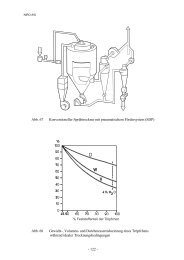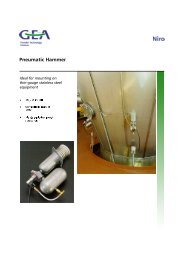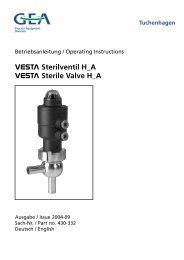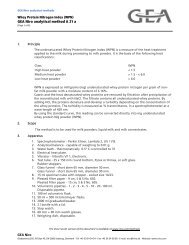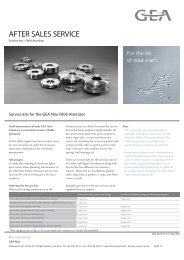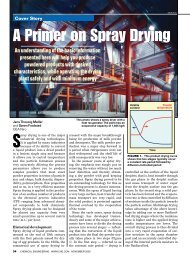41119_Niro jubilaeumsbog_blok_uk - GEA Niro
41119_Niro jubilaeumsbog_blok_uk - GEA Niro
41119_Niro jubilaeumsbog_blok_uk - GEA Niro
You also want an ePaper? Increase the reach of your titles
YUMPU automatically turns print PDFs into web optimized ePapers that Google loves.
NOZZLE TOWER spray dryer for production<br />
of the polymer Polyacrylonitrile in<br />
the Netherlands.<br />
By Henrik Bender Mortensen and Claus Lemb<br />
When the kids play with balls or LEGO ® blocks, <strong>Niro</strong> has<br />
probably been in the game. And when Dad plays handyman<br />
and uses electrical cables or puts up gutters, or Mom wipes<br />
down the deck chairs, <strong>Niro</strong> might also have been part of the<br />
process. LEGO ® blocks, electric cables, gutters and plastic<br />
garden furniture consist of polymers, which can have been<br />
dried in a <strong>Niro</strong> plant.<br />
There are many different polymers. Polymers are used in<br />
the fashion industry for shoes and belts, in kitchenware such<br />
as ladles and mixing bowls, as well as in packaging and white<br />
glue. Already in the early 1950s, <strong>Niro</strong> started selling spray<br />
drying plants to the part of the PVC business that produces<br />
soft toys and electrical cables, among other things. Good<br />
connections helped <strong>Niro</strong> get orders for a number of plants,<br />
and in the early 1960s <strong>Niro</strong> developed flash and fluid bed<br />
drying plants for a type of PVC used among other things for<br />
gutters and garden furniture.<br />
In the early 1970s the market changed, so that the type of<br />
PVC used in soft toys and cable insulation became by far<br />
the biggest part of the market. At that time <strong>Niro</strong> had sold a<br />
number of flash fluid bed plants and about 100 spray drying<br />
plants. The focus was switched, and since then <strong>Niro</strong> has sold<br />
roughly 200 flash and fluid bed plants and more than 100<br />
spray drying plants.<br />
The first PVC plant was able to produce four tons of product<br />
per hour, while the plants that <strong>Niro</strong> delivers today are able<br />
to produce more than 40 tons of product per hour. During<br />
the 1980s and ‘90s, the polymer market ran out of steam.<br />
But since 1998, <strong>Niro</strong> has sold more than 70 drying plants for<br />
the production of polymers, of which many large ones are<br />
sold especially to the Chinese market.



